Podcast
Questions and Answers
Care este unul dintre noile materiale introduse in tehnologia de printare 3D?
Care este unul dintre noile materiale introduse in tehnologia de printare 3D?
- Fibre de carbon (correct)
- Sticla
- Plastic reciclabil
- Hartie
Ce este una dintre aplicatiile revolutionare ale printarii 3D in domeniul medical?
Ce este una dintre aplicatiile revolutionare ale printarii 3D in domeniul medical?
- Jucarii imprimate 3D
- Mobilier de birou
- Implanturi medicale personalizate (correct)
- Articole de imbracaminte
Care este una dintre modalitatile in care printarea 3D contribuie la explorarea spatiala?
Care este una dintre modalitatile in care printarea 3D contribuie la explorarea spatiala?
- Reducerea nevoii de misiuni de reaprovizionare (correct)
- Sondarea suprafetei planetelor
- Construirea de noi vehicule spatiale
- Imprimarea de haine spatiale
Care este unul dintre avantajele inovatiilor recente in ceea ce priveste viteza si precizia printarii 3D?
Care este unul dintre avantajele inovatiilor recente in ceea ce priveste viteza si precizia printarii 3D?
Care este unul dintre modurile in care printarea 3D contribuie la sustenabilitate?
Care este unul dintre modurile in care printarea 3D contribuie la sustenabilitate?
Care este tipul cel mai comun de imprimare 3D care folosește un material pe bază de filament, încălzit până la starea topită și extras strat cu strat?
Care este tipul cel mai comun de imprimare 3D care folosește un material pe bază de filament, încălzit până la starea topită și extras strat cu strat?
Ce tip de imprimare 3D folosește o rășină lichidă întărită de un laser pentru a crea modele 3D?
Ce tip de imprimare 3D folosește o rășină lichidă întărită de un laser pentru a crea modele 3D?
Care este o aplicație populară a imprimării 3D în domeniul modei?
Care este o aplicație populară a imprimării 3D în domeniul modei?
Care dintre următoarele este un proces de imprimare 3D care folosește o prelucrare pe bază de pulberi cu ajutorul unui laser pentru a sinteriza materialul?
Care dintre următoarele este un proces de imprimare 3D care folosește o prelucrare pe bază de pulberi cu ajutorul unui laser pentru a sinteriza materialul?
Ce tehnologie de imprimare 3D utilizează un proiector de lumină digital pentru a produce modele 3D cu rezoluție mare?
Ce tehnologie de imprimare 3D utilizează un proiector de lumină digital pentru a produce modele 3D cu rezoluție mare?
Care este o strategie de optimizare pentru suporturile de imprimare 3D?
Care este o strategie de optimizare pentru suporturile de imprimare 3D?
Ce tehnica poate imbunatati aspectul, rezistenta si durabilitatea pieselor imprimate 3D?
Ce tehnica poate imbunatati aspectul, rezistenta si durabilitatea pieselor imprimate 3D?
Ce poate îmbunătăți performanța tipăririi 3D prin îmbunătățirea aderenței stratului?
Ce poate îmbunătăți performanța tipăririi 3D prin îmbunătățirea aderenței stratului?
Cum se poate reduce timpul de imprimare prin tehnici de post-procesare?
Cum se poate reduce timpul de imprimare prin tehnici de post-procesare?
Ce efect are utilizarea unor materiale de suport care pot fi îndepărtate asupra procesului de imprimare 3D?
Ce efect are utilizarea unor materiale de suport care pot fi îndepărtate asupra procesului de imprimare 3D?
Care este un mod eficient de optimizare a utilizării materialelor în imprimarea 3D?
Care este un mod eficient de optimizare a utilizării materialelor în imprimarea 3D?
Ce tehnica de optimizare poate reduce timpul de producție și costurile în imprimarea 3D?
Ce tehnica de optimizare poate reduce timpul de producție și costurile în imprimarea 3D?
Ce strategie poate ajuta la economisirea materialelor și la reducerea risipei în imprimarea 3D?
Ce strategie poate ajuta la economisirea materialelor și la reducerea risipei în imprimarea 3D?
Cum poate creșterea lățimii de extruziune afecta utilizarea materialului în imprimarea 3D?
Cum poate creșterea lățimii de extruziune afecta utilizarea materialului în imprimarea 3D?
Ce impact poate avea alegerea unui material mai eco-friendly asupra procesului de imprimare 3D?
Ce impact poate avea alegerea unui material mai eco-friendly asupra procesului de imprimare 3D?
Flashcards are hidden until you start studying
Study Notes
3D Printing: Advancements, Applications, and Types
3D printing, also known as additive manufacturing, has revolutionized the way we create objects, innovate designs, and manufacture products. Below, we explore the recent advancements, diverse applications, and various types of 3D printing technology.
Advancements in 3D Printing
- Materials: New materials like carbon fiber, metals, and biodegradable plastics have been introduced, expanding the range of applications and industries.
- Speed and Accuracy: Continuous advancements in printing speed and precision have led to more complex and intricate designs, while reducing production time and costs.
- Sustainability: Eco-friendly materials, recycling initiatives, and energy-efficient manufacturing processes help make 3D printing more environmentally conscious.
- Automation: The integration of automation and artificial intelligence in 3D printing improves efficiency and quality, while reducing human error.
Applications of 3D Printing
- Medical: Personalized prosthetics, medical implants, and organ prints are some of the applications that have revolutionized healthcare and brought new hope to patients.
- Space exploration: 3D printing allows for the creation of spare parts and tools in space, reducing the need for resupply missions.
- Aerospace: 3D printed wings, engines, and satellites are lightweight and more efficient, contributing to the innovation and success of aerospace companies.
- Automotive: Car parts like bumpers, dashboards, and engine components are being printed, reducing weight and improving performance.
- Architecture and construction: 3D printed houses, bridges, and other construction elements have gained attention for their affordability, efficiency, and sustainability.
- Fashion: Custom-made clothing and accessories, such as shoes and jewelry, have emerged as popular applications of 3D printing.
Types of 3D Printing
- Fused Deposition Modeling (FDM): The most common type of 3D printing that uses a filament-based material, heated to a molten state and extruded layer by layer.
- Stereolithography (SLA): A light-based 3D printing process that uses a liquid resin, hardened by a laser, to create 3D models.
- Selective Laser Sintering (SLS): A powders-based process using a laser to sinter the material, creating a strong and durable object.
- Digital Light Processing (DLP): A variation of SLA that uses a digital light projector instead of a laser, producing high-resolution 3D printed models.
- Electron Beam Melting (EBM): A powder-based process that uses an electron beam to melt and fuse metal particles, creating complex metal structures.
- Binder Jetting: An inkjet-based process that uses a binder to join together powdered materials, creating a strong object.
In conclusion, 3D printing has grown into a thriving industry that offers numerous opportunities and benefits across various applications. As advancements continue, we can expect to see more innovative uses of 3D printing technology in the future.
Studying That Suits You
Use AI to generate personalized quizzes and flashcards to suit your learning preferences.





